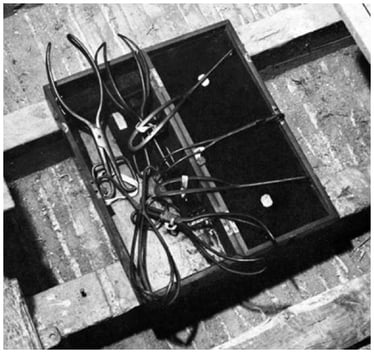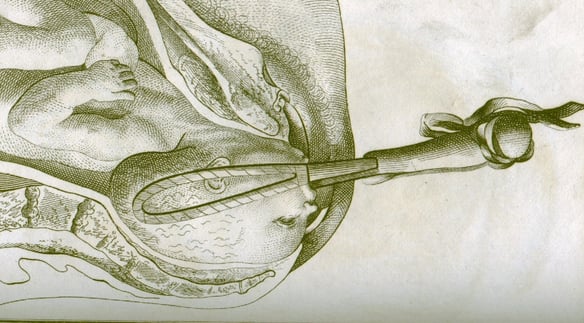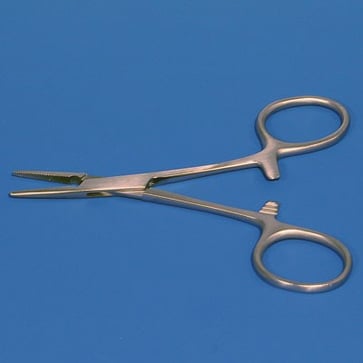Forceps were originally designed to help deliver a baby in an era where many women died from childbirth. The origin of the word comes from Latin, “forca,” which means to grab or grip an object. Forceps illustrated in ancient documents would have served as destructive instruments rather than aiding ones. There was little or no concern for the baby, and many were stillborn before any form of intervention was considered. During the middle ages, mechanical assistance was provided when delivery was obstructed. Instruments used by the Barber Surgeon or ladles from the kitchen were used to help a woman give birth. At that time, midwives were in charge of managing a hard labor, however, there are few written accounts of the process. Midwifery was almost a taboo, and mainly controlled by the church. The practice was cloaked in superstition. There is an example from a “Dame Trot” who practiced in Salermo during the 11th century: “When there is a difficult labour with a dead child, place the patient in a sheet held at the corners by four strong men, with her head somewhat elevated. Have them shake the sheet vigorously by pulling on the opposite corners, and with God’s will she will give birth.”1
Origins of the Obstetric Forceps
It was not until the 16th and 17th century that new ideas began to develop, and the story of the obstetrician’s forceps started, with the Chamberlen family. After the battle of Jarnac in 1569, Catherine de Medici, the Catholic Queen Mother and governor of France, banned Protestant (Huguenot) physicians and many had to flee France if they wanted to continue practicing. This is when the French Huguenot, William Chamberlen migrated to England with his family. His two sons, Peter the elder and Peter the younger, both became members of the Barbers Surgeon Company, and both were fined for not attending lectures, and fell out of the College of Physicians. It is unclear which of the two came up with the idea of the forceps, but many historians believe it was Peter the elder, because he attended Queen Henrietta Maria, wife of Charles I, and was present during the birth of their child, Charles II in 1630. It was Peter the younger’s son, known as Dr. Peter Chamberlen or Peter the Third, who actually received formal education at the Universities of Oxford, Cambridge, Padua and Heidelberg.2

The Chamberlens took great care to keep their instruments in the dark. They concealed their forceps in a gilded chest and opened it only after the woman in labor had been blindfolded. The birth took place under blankets where only the Chamberlens, were left to attend the patient.3
Original Chamberlen forceps found in secret compartment at Woodham Mortimer, Essex. * Reproduced with the permission of the Royal College of Obstetricians and Gynaecologists.
The 18th Century
By mid18th century a new circle of midwives were established, and among them, William Smellie became the most outstanding obstetrician of the time. He developed his own forceps to “avoid this loss of children which gave him great uneasiness.”4

Smellie's forceps © Public Domain
The features that Smellie used to design his instruments still remain in present time. He took care to consider the woman’s pelvic curve and was the first physician to describe the rotation of the baby’s head with the forceps. Smellie’s understanding of a woman’s anatomy made him care about the forceps’ blades design. Although they were made of iron, the blades were slender and broader at the tips. They were covered with leather and lubricated with pigs lard before using.5
From the 19th Century to Our Times
During this time, the British started manufacturing instruments in carbon steel and stainless steel, which is a lighter material. Although other different and complex designs for forceps emerged throughout Europe, the original designs from mid18th century continued to be used. The introduction of anesthesia and more fetal considerations started to prevail, making the Caesarean section safer. High forceps slowly became obsolete and more precaution was employed when using mid-cavity forceps. The baby’s rotation of the head as a technique became extinct as well. There was a rising concern to protect the baby’s head rather than compressing it. By mid-20 century a vacuum extractor started to replace forceps in many hospitals, but it’s no longer popular today. Currently the Caesarean section seems to dominate as the solution to a difficult birth. The use of forceps has changed dramatically, and even though the obstetrician forceps is still available, it is employed sparingly as a last resort when there is no risk of damaging the baby or the woman. Today forceps are used for other several uses. The most common types of forceps used in today’s medical field are: 6
- Dressing forceps – used for dressing wounds and for removing dressings
- Hemostats forceps – used to prevent the flow of blood during surgery, to control hemorrhage

- Splinter forceps – used to remove pieces of bone from the flesh, handle sutures, or to manipulate narrow areas
- Sponge forceps – used to clamp, hold or grip tissues, sponges or gauze, and also used to insert devices in the body
- Needle holders – used to hold needles during procedures
- Tissue forceps – provide better grip to hold tissues because they have teeth, specially designed to hold them firm without causing damage Sklar's Hemostat Mosquito Forceps
- Tubing forceps – used to insert tubes inside a small blood vessel during a surgical procedure
- Towel forceps – used to hold towels, or pieces of towels, in the appropriate position while operating
If you would like to browse through Sklar's fine line of surgical forceps, please click the button below.
References
1, 4, 5 Hibbard, Bryan (2000) Milestones in the evolution of obstetric forceps
2 Katz, David S. (1988) Sabbath and sectarianism in seventeenth-century England
3 Sheikh, Sukhera. (2013) The birth of forceps
6 Waqaas. (2012) Surgical Instruments Usage – Forceps



